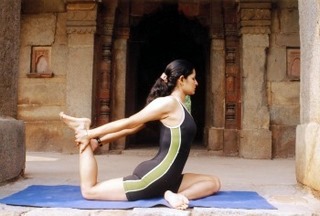Yoga Etiquette
~Centering Yourself~
Yoga etiquette is truly about creating a peace about yourself and respect for others who have embarked on this journey of self improvement. Yoga is a peaceful, introspective practice. It should be done with a calmness and dignity.
Fortunately, there are yoga classes available for those of us
who
are new to the practice or those seasoned veterans who need guidance.
There are many different types of yoga, as well as levels. 
This page is dedicated to all who practice yoga, no matter the style, place or level. The following guidelines will give you what you need to have the best experience you can, while at the same time allowing everyone around you the same courtesy.
Yoga Etiquettes
- Time Etiquette. Actually good yoga etiquette is shown when you arrive 10-15 minutes before class. If it is your first class, you should arrive 20 minutes early to register, sign in and receive all of the information necessary.
- Shoe Etiquette. Normally there are designated areas near the front door for shoes to be left during class. Yoga is practiced in your bare feet. By removing your shoes when you first come in, you will keep all of the dirt and other lovely things shoes have on them from being tracked in and around the studio.
- Cell Phone Etiquette. It is very difficult to center yourself if your mind is wondering about who is going to call or message you during class. It is also bad yoga etiquette to leave it on so that it can ring or buzz during class. The easiest way to avoid any of this is simply turn it off for the period of the class. It will free your mind to concentrate on the journey before you.
- Mat Etiquette. A yoga mat is essential to good practice. It is essential that you take care of your mat, by cleaning it on a regular basis. If you are using a studio mat, be sure to wipe it down after class and place it where it needs to be. When you get to your spot in the studio, roll your mat out rather than flinging it like a tablecloth. Do not step or walk on other people's mats as you are moving about the room. It is their space.
- Space Etiquette. A yoga studio is normally designed that all participants should have adequate space to get into their poses without infringing on another's area. Allow plenty of space for someone who is taller, because they will need it.
- Noise Etiquette. When you are entering class, keep the noise level to a minimum. Chatting and moving around like an elephant is disrespectful to those who are already there. During class, try to avoid the noises that those lifting weights tend to make. Some of the poses are difficult and can elicit a sigh or quiet moan, however grunting, yelling out in pain or loud moaning is not necessary. If you are in that much pain, that is your body telling you to back off or adjust your pose.
- Personal Etiquette. When practicing yoga, you are in a very close space. It is easy for odors (good and bad) to travel quickly. Any type of strong odor can be very distracting to other people in the class. Be sure to remove any strong odors associated with your body, whether it be sweat or perfume. Clean feet are a good thing too.
- Dress Etiquette. Showing respect in class involves dressing appropriately for a yoga class. Good yoga etiquette is shown when you are wearing clothes that will allow you to move through the poses without worrying about adjustments and revealing.
- Teacher
Etiquette. Yoga instructors have spent many hours
refining their
 practice so that they can share their knowledge
with you. They are very
skilled at their craft.
Respecting their knowledge is good yoga etiquette. Follow the class as
they have designed it. If you need to adjust your pose, do so
accordingly. It is very distracting to the teacher and other students
to have someone doing their own routine in the middle of class. It
interrupts the flow and makes it hard to concentrate. If you have
suggestions you would like to share with the teacher, do so before or
after class off to the side.
practice so that they can share their knowledge
with you. They are very
skilled at their craft.
Respecting their knowledge is good yoga etiquette. Follow the class as
they have designed it. If you need to adjust your pose, do so
accordingly. It is very distracting to the teacher and other students
to have someone doing their own routine in the middle of class. It
interrupts the flow and makes it hard to concentrate. If you have
suggestions you would like to share with the teacher, do so before or
after class off to the side. - Children Etiquette. Unless they are there to practice with you, and are at a mature enough level to do so, leave your children at home. It is too much to ask a young child to sit quietly through a yoga class. Every time they would need to talk to you they would pull, not only you, but everyone else around you out of your inner peace.
- Gum Etiquette. Don't chew it in class. That's about it.
- Bathroom Etiquette. Save your bathroom breaks for resting periods of class. The most common rest times are during Child's Pose or Downward Dog. Quietly leave the room and quietly re-enter the room and join the class.
- Savasana Etiquette. This is the final relaxation of the class and is very valuable to all who have just completed a yoga journey. It is essential that you do not skip this portion of class. It is easy to justify leaving, however doing so will cause noise and disrupt the peace that comes over the class at this time.





